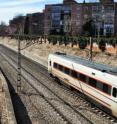Virtual laboratory predicts train vibrations
The construction of new rail lines, or the relocation of old ones underground, has increased society's interest over recent years in the vibrations produced by trains, especially among people who live or work near the tracks. Now a study headed by the Polytechnic University of Valencia (UPV) has made it possible to estimate the trajectory of vibrations from the point at which they are generated (wheel-rail contact) through to the ground. "The model acts as a "virtual train laboratory', meaning that, if the parameters of the train or the track ballast are changed, it is possible to infer the pattern of the resulting vibrations", Julia Real, professor of transport and railways at the UPV and lead author of the study, tells SINC. "This is ideal for testing changes that, if they work, could be put into practice".
If, for example, the data from an AVE high speed train with an aerodynamic nose are entered rather than those from another train with different mechanical characteristics, different vibration patterns are obtained. The same thing happens when comparing a track without any levelling defects with another older one, or if the condition or type of material used beneath the sleepers are changed.
"The results depend to a large extent on the elasticity, density and thickness of the materials, especially the ballast (gravel that the sleepers rest on)", points out Pablo Salvador, another UPV researcher, who is also a co-author of the study.
The scientists created the analytical model using mathematical equations that describe the frequency and number of waves. The details are published in the Journal Mathematical and Computer Modelling.
"It's a fairly robust model that is relatively simple to use, and which makes it possible to determine potential vibration levels in an area following the introduction of a rail line, and also provides input information for a 2D surface vibration propagation system", explains Salvador.
Validation on the Madrid-Barcelona line
The theoretical results have been successfully compared with experimental frequency and vibration duration measurements taken along the Madrid-Barcelona high speed line. This information was provided by the public company Ineco, which is attached to the Ministry of Public Works.
This study is the first of a series of three, which will use the same methodology to analyse two other rail facilities – an urban tram line (line 1 of the FGV in Alicante) and a Spanish narrow gauge railway along the Santander-Liérganes line.
"In the first case, which has just been published, we focused on 'the best' (new vehicles and tracks meeting maximum speed and international gauge requirements); in the second case, the urban tram calls for the greatest possible attention with regard to vibrations, requiring extreme care even though they have only small loads and speeds; and the third case will look at a mixed rail operation (passengers and merchandise) making optimum use of resources", explains Julia Real.
"These are three different kinds of rail facility, each having its own structure, requirements and determining factors… but all of which are tremendously efficient with regard to society and the environment", the researcher concludes.
Source: FECYT - Spanish Foundation for Science and Technology
Other sources
- Virtual laboratory predicts train vibrationsfrom Science DailyWed, 9 Feb 2011, 16:31:47 UTC
- Virtual laboratory predicts train vibrationsfrom PhysorgWed, 9 Feb 2011, 15:30:27 UTC
- Virtual laboratory predicts train vibrationsfrom Science BlogWed, 9 Feb 2011, 15:03:19 UTC
